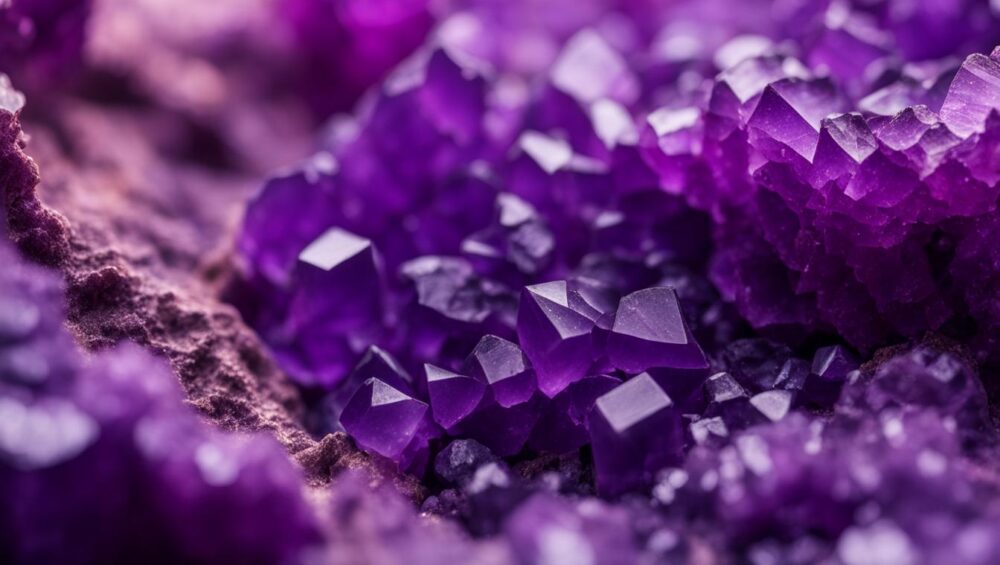Amethyst is a captivating gemstone known for its enchanting purple color. However, contrary to popular belief, amethyst can come in different colors and hues. The color of amethyst is influenced by iron impurities found in its crystal quartz structure, which can result in a range of purple shades.
Some common variations of amethyst include traditional amethyst with deep purple hues, rose de France amethyst with a lighter lavender shade, green amethyst (also known as prasiolite) with a unique greenish hue, and bi-color amethyst that showcases a fusion of different colors within a single gemstone.
Additionally, the color of amethyst holds symbolic meanings and carries psychological benefits, such as promoting calmness and inner peace. Overall, there is a diverse range of colors and tones to be found within the world of amethyst.
Key Takeaways:
- Amethyst can come in different colors and hues.
- Variations of amethyst include deep purple, lavender, green, and bi-color.
- The color of amethyst holds symbolic meanings and promotes inner peace.
The Geological Origins and Sources of Amethyst
Amethyst, a mesmerizing gemstone renowned for its captivating purple color, has intriguing geological origins. This type of quartz is formed through natural processes involving heat, pressure, and the presence of trace elements. The stunning purple hue of amethyst can be attributed to iron impurities within its crystal structure.
Amethyst can be found in various locations around the world, each contributing to the diverse range of colors and variations of this gemstone. Some notable sources of amethyst include:
- Brazil: Brazil is renowned for its vast amethyst deposits. The country produces a significant amount of amethyst in different shades and intensities, offering a wide array of options for gem enthusiasts.
- Uruguay: Uruguay is known for its exceptional amethyst, particularly the deep purple variety similar to the renowned Siberian amethyst found in Russia. The rich hues and high-quality of Uruguayan amethyst make it highly sought after by collectors and jewelry designers.
- Zambia: Zambia is recognized for its intense and rich purple amethyst. The gemstones sourced from this region often exhibit vibrant colors and excellent clarity, making them highly prized in the market.
- Russia: Russia is famous for its Siberian amethyst, which is characterized by its exquisite deep purple color. This high-quality amethyst is highly valued for its exceptional beauty and rarity.
These natural locations play a significant role in shaping the color variations of amethyst, offering a diverse range of options to suit different preferences and styles.
Understanding the geological origins and sources of amethyst provides valuable insights into the unique characteristics and color variations of this captivating gemstone.
The Importance of Color in Amethyst and Care Tips
The color of amethyst plays a vital role in determining its quality and value. From deep purples to intense royal purples, the desirable hues of amethyst captivate the eye and add to the beauty of the gemstone. The saturation or depth of the purple hue further enhances the visual appeal of amethyst.
Clarity is another crucial factor to consider when appreciating amethyst. A high-quality amethyst gemstone should exhibit transparency and minimal visible inclusions, ensuring a clear and pristine appearance.
To preserve the color and vibrancy of your amethyst jewelry, proper care and maintenance are key. It is advisable to avoid exposing your amethyst jewelry to prolonged sunlight or extreme heat, as these elements can cause fading or unwanted color changes. It is best to store your amethyst jewelry in a cool, dry place away from direct sunlight.
Regular cleaning of amethyst jewelry is essential. Gently wash your jewelry with mild soapy water to remove any dirt or residue, and make sure to avoid using harsh chemicals or ultrasonic cleaners. Remember to dry your jewelry thoroughly before storing it. For added peace of mind, it is recommended to have your amethyst jewelry inspected and professionally cleaned by a trusted jeweler.
By following these care tips, you can ensure that your amethyst jewelry retains its stunning colors for years to come, allowing you to continue enjoying the beauty and allure of this mesmerizing gemstone.
FAQ
Can amethyst come in different colors?
Yes, amethyst can come in different colors and hues due to the influence of iron impurities in its crystal quartz structure.
What are the types of amethyst colors?
Some common variations of amethyst include traditional deep purple amethyst, lighter lavender rose de France amethyst, green amethyst with a unique greenish hue, and bi-color amethyst featuring a fusion of different colors within a single gemstone.
Are there various shades of amethyst?
Yes, amethyst comes in various shades, ranging from deep purples to intense royal purples.
Where can I find different hues of amethyst crystals?
Amethyst can be found in various locations worldwide, with notable sources including Brazil, Uruguay, Zambia, and Russia.
What is the significance of the color of amethyst?
The color of amethyst holds symbolic meanings and is associated with psychological benefits, such as promoting calmness and inner peace.
How do I care for amethyst jewelry?
To preserve the color of amethyst jewelry, avoid prolonged exposure to direct sunlight or extreme heat. Clean gently with mild soapy water and avoid harsh chemicals or ultrasonic cleaners. Periodic inspections and professional cleaning by a trusted jeweler are recommended.




